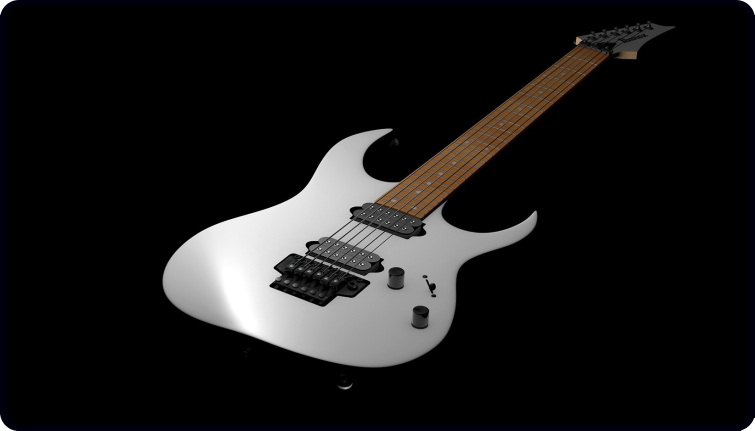Welcome to a new Monday post with 3 random thoughts on all things guitar, music, and life, including being in love with the guitar, contrast as a secret ingredient, and more. Here we go…
#1 – No practice time!
A lot of people beat themselves up for not practising the guitar enough.
You might be one of those.
If so, you might wonder what you can do about it.
Well, firstly, I’d say do what it takes to fall in love with the guitar.
…Because when you are truly in love with the instrument, it’s kind of like being in love with a person.
You know the feeling.
When you get the rush and thrill of being in love, you cannot wait to be with that person, you hate being apart from them, and you’ll likely move heaven and earth to be with them.
Yes, this might sound a little mushy (Valentine’s Day is around the corner after all).
It’s the same with the guitar though.
If a student is truly in love with playing the guitar, they will usually find a way, somehow, to practise more.
…And then, you’ll find an extra 5, 10, 15, or even 30 minutes throughout the day to play your favourite song, jam the music you love, or relax with some creative “noodling”.
I’ll talk about finding time to practise more this week, but honestly, if you feel you are too busy to practise, start by asking yourself, are you truly in love with the guitar yet?
If not, let’s make it happen!
I usually find it all starts with finding one piece of music that you really love playing and going from there.
#2 – The secret ingredient of contrast
I touched on this in yesterday’s email about Django Reinhardt and James Taylor.
It is the magical power of “contrast”.
You see, in music, contrast is extremely effective.
A lot of the most famous songs have contrast in them. For instance: the melody of a verse that is low in pitch while the chorus soars with much higher-pitched notes.
A fingerpicked section followed by a big strummed chorus.
…And then there are some songs that have contrast in the actual guitar parts themselves.
For instance, you can combine deep bass notes on the guitar and higher-string treble notes.
That can be a powerful thing.
You see, many guitarists use a small range of notes on the guitar.
They don’t really tend to use the lowest note of E that much and rarer still, they often avoid the 8th, 10th, or 12th frets (and beyond) of the guitar on the high E string.
This means a lot of guitarists tend to play in the “middle”, but a really cool thing to do is think about how you can use the low notes and the high notes.
There is a lot of contrast to be had in using the range of the instrument like this which sounds exciting.
Try it.
Go low and high – it can be a fun way to play.
#3 – The problem with most songs
Over the years, I’ve found many commonly taught guitar songs can be pretty boring to play.
If you’ve spent time on YouTube for any number of hours, you probably know this.
It seems to me that most acoustic songs fall into these percentages:
60% strumming songs – where you need the singing for them to sound recognisable.
30% fingerpicking songs – where you need the fingerpicking pattern. These songs are more interesting to play, but they usually also need the singing.
10% solo fingerstyle arrangements – these are usually way too complex for beginners, can be really tough to play, and are beyond the ability of most beginners.
Of course, this is not an exact percentage split, but that is the gist of most song lessons from my experience.
Therefore, it’s no wonder a good chunk of people find the guitar to be more frustrating than trying to navigate through London traffic at rush hour!
It’s also no wonder a big chunk of people find it a bit boring and aren’t all that motivated to play.
That’s why I do my own thing compared to the YouTube gurus when it comes to teaching the guitar and songs.
On that note, if you want to end boredom and end frustration, the new lessons in the Dan Thorpe Acoustic Academy can help.
Not only will you learn a simple but very famous song played in an impressive fingerstyle manner that does NOT use any chords and it’s one that ALL beginners can learn…
You will also discover one of the most powerful techniques for changing chords I’ve ever taught, and you’ll learn a simple magic ingredient for adding more excitement to any melody, instantly.
It’s all in the Dan Thorpe Acoustic Academy and the new lessons go out on Wednesday.
To get them, you will need to join before the midnight deadline on that day.
The Dan Thorpe Acoustic Academy
I hope you enjoyed these three thoughts and you have a great week ahead!
Dan Thorpe
Guitar Domination
P.S. This post was originally taken from Dan Thorpe’s private email list. To get blog posts like this sent to you which are full of great tips to make fingerpicking, strumming, and learning guitar more enjoyable (especially if you are over 40) join Dan’s list. It’s 100% free, HERE.


Add Comment